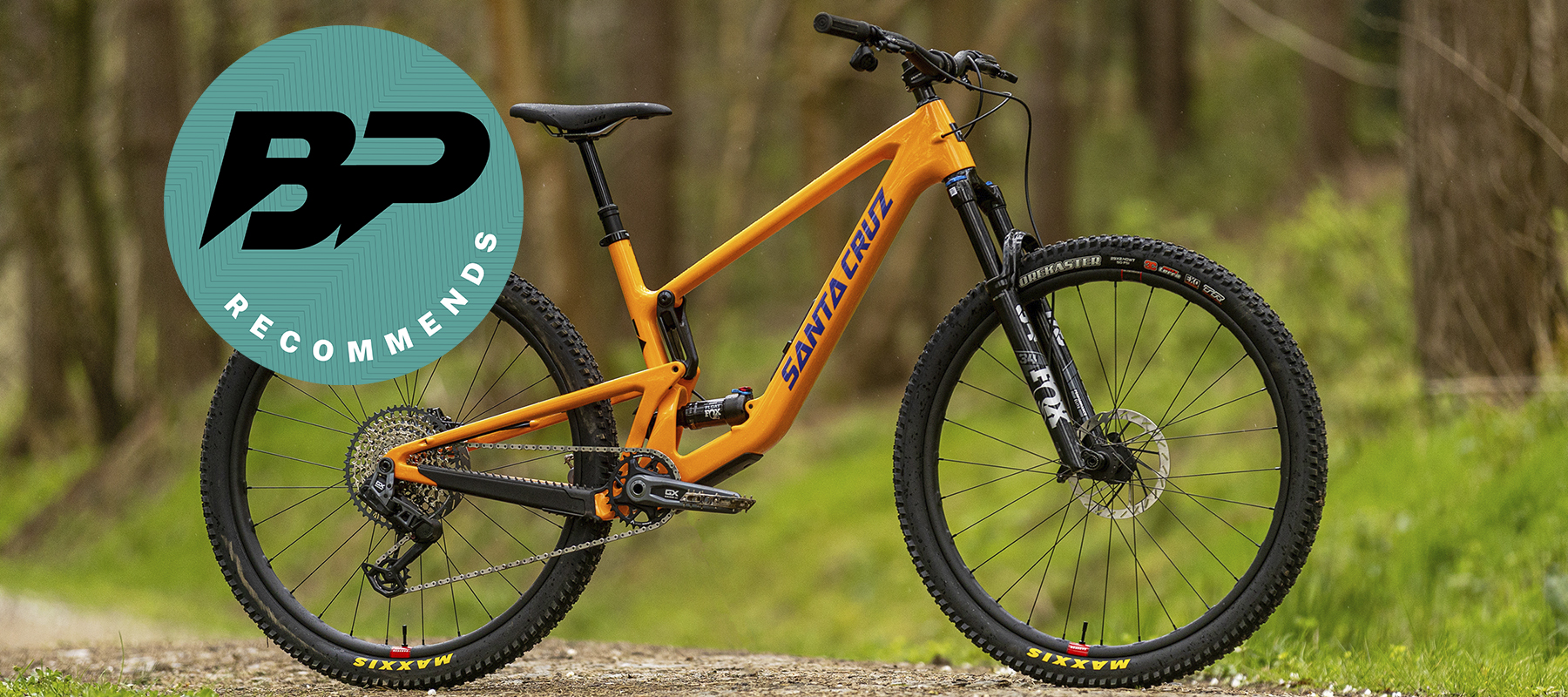Bike Perfect Verdict
The latest Tallboy is fast and responsive and perfectly balances never sapping your energy with not sapping your thrills. The GX AXS RSV package calmly feeds back so much about what you’re doing, it allows you to ride right at the limit and just about get away with it. For my money, only a couple of component choices stop it being a totally perfect trail machine.
Pros
- +
Fast everywhere with brilliant pedaling manners
- +
This thing really sprints if you give it some beans
- +
Fantastic shape and meaningful geometry adjustment
- +
Rock-solid chassis and balanced handling
- +
Fox suspension is perfectly tuned
- +
Reserve Carbon SL wheels are super-fast and still comfortable
Cons
- -
SRAM Level brakes lack power
- -
OneUp dropper remote is very sharp at the tip
- -
Tempts you into pumping up the build kit for more DH capability with bigger tires and brakes, adding weight and ruining the bike’s all-round versatility
Why trust BikePerfect
The Tallboy has been around in Santa Cruz’s lineup for what feels like forever. It actually launched way back in 2009 and was one of the first 29in mountain bikes to gain much traction at a time when 26in wheels ruled the roost across every category from Lycra-clad XC whippets to baggy kit-wearing motocross-influenced DH huckers.
With an aluminum frame and 100mm rear travel, the original model had a much more climb-orientated and cross-country outlook than this latest fifth-generation shape that sells itself as the "downhiller’s XC bike" – which translates well to being one of the best short travel trail bikes around. Tallboy 1 presumably wouldn’t be slaying too many downhills with its maximum recommended tire width of 2.35in and 135x12mm bolt thru-axle, which I can barely remember was even a ‘thing’.
Over the years, the Tallboy has morphed into a slick full carbon fiber chassis and also become way burlier, lower slung and more slacked out at the head tube (the original’s head angle is so laughably steep, it looks more like a circus trick bike than a modern trail bike).
Like most of Santa Cruz’s range, the Tallboy also switched along the way from a design where the rear shock bolted to the underside of the top tube into a much more refined lower link-style VPP suspension layout. In my experience, this shift has taken Santa Cruz bikes’ suspension performance forwards in giant leaps. Even with a much cleaner look, it retains one of the Virtual Pivot Point’s USP of counter-rotating links for maximum leverage rate and wheel path manipulation to tune the suspension exactly as engineers want it.

Tallboy 4 first packaged this design much more cleanly by wrapping the lower link down inside the rear triangle and seat tube and piercing the frame, but this fifth version refines it further, adds Glovebox internal storage, and likewise sees the shock moving back and forth through the heart of the chassis.
The Tallboy 5 is available in multiple colors, models and guises, including two tiers of carbon fiber. One is the cheaper C model using a more affordable lay-up and construction I’m testing here that’s a few hundred grams heavier, and there’s also a CC version using lighter, stiffer and finer carbon fibers, with a corresponding hike in cost. Both promise the same stiffness, flex profile and ride quality, and both come with a lifetime warranty on the carbon chassis itself and all bearings, which the brand is famous for being very good about honoring for riders.
This GX AXS RSV model uses the brand’s own (well, Reserve’s) superb SL carbon wheels and is the most expensive package built around the ‘C’ frame. I rode the pricier CC version a lot last year in a similar build spec (which is exactly the reason why I wanted to get this bike back in to test!), so am pretty well placed to comment that Santa Cruz is bang on the money with its ride quality claims and I reckon there’s minimal noticeable ride difference between the two carbon tiers, aside from the extra weight.

Design and geometry
The headline here is of a bike offering 120mm rear and 130mm front travel, but if that sounds like a set of mile-munching, short travel numbers for steady-away riding, you better think again. Santa Cruz not only builds this thing to handle the abuse of hard-charging riders, but the geometry and construction are optimized for speed too – with a very stiff and solid chassis for its category, and angles that are equally at home when the trails tip you downwards and into the steeps.
In a size Large, that means a 475mm reach, 437mm chainstays and a 65.5 degree head angle in the lower position. All Tallboy 5 frames grow proportionally with rider size, so chainstays climb from 430mm on XS to 444mm on XL and head tubes from 95mm to 155mm. It’s fair to say this is a significant differentiation to match all rider shapes and heights that trumps what most other brands are doing.
All frame sizes share the same relatively low BB height of 332mm (in the sunken flip chip position) as well as a well-sorted and roomy frame storage space called Glovebox that comes with a fitted tool wallet. The Tallboy’s seat angle is just as contemporary, and between 76 to 77 degrees, dependent on frame size. This ensures hips and rider weight are in a good pedaling position for climbing or getting about the place fast.
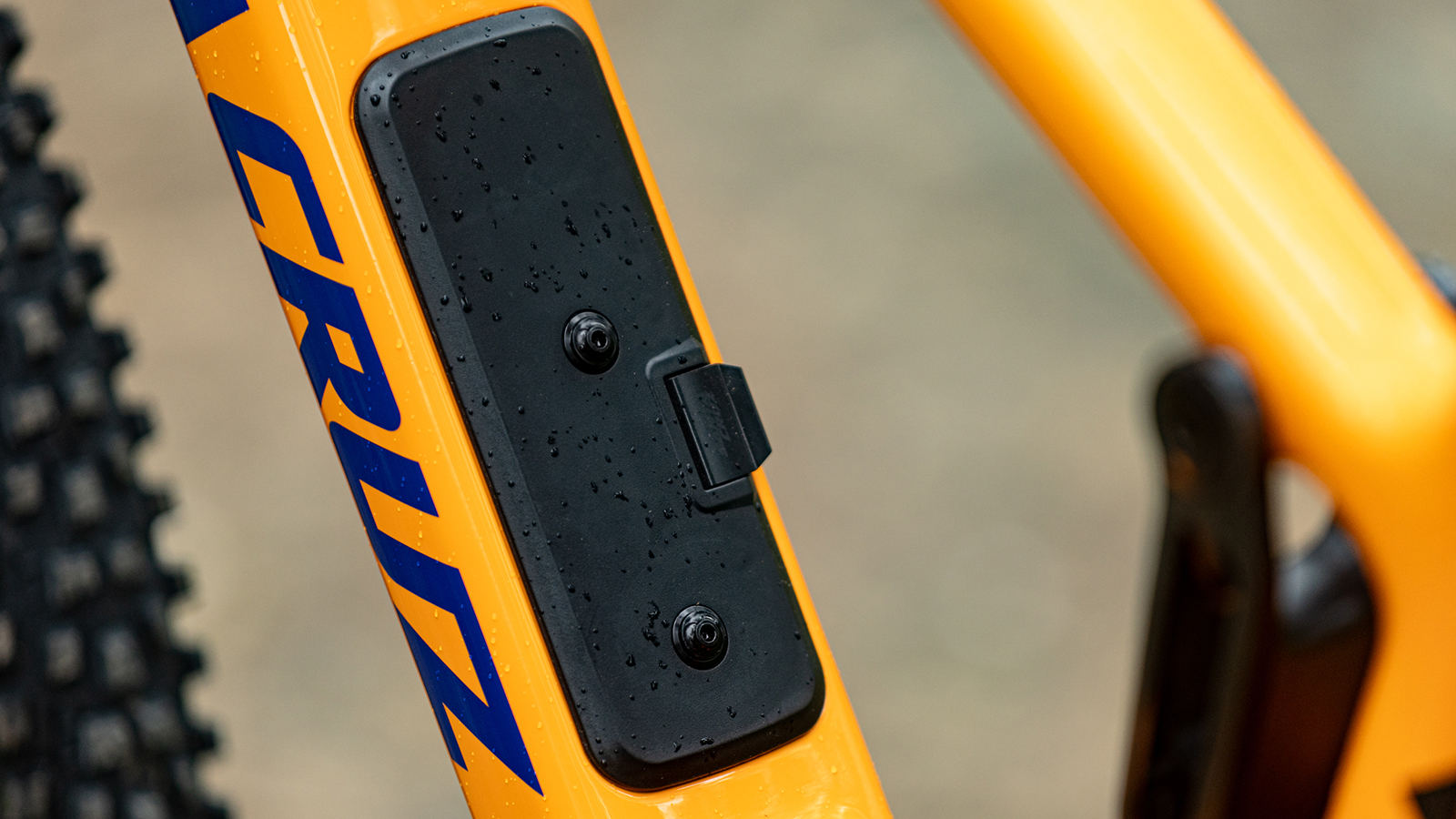
Fashions come and go and it appears threaded BBs are trendy again, but Santa Cruz never lost the faith and continued to spec them while other brands looked towards often creaky and problematic press-fit options elsewhere. This ties into the brand’s focus on ease of maintenance and durability that extends to a lifetime warranty on all frame bearings and no rider weight limit on any of its bikes. There is also a lifetime replacement guarantee on the Reserve 30 SL wheels.
The Tallboy not only looks contemporary and clean, but all the technical details needed to make it silent and user-friendly are totally dialed too. There's a tidy head tube (not headset) cable routing using in-molded cable tunnels for ease of servicing, all the quietening and damping protection where you need it, and a grease port to keep the lower link running smoothly.
The frame also has plenty of mud clearance and the rear stays are kinked inwards at the point of the widest tire profile so you can forget about the 2.35in limit on the original Tallboy and happily use even 2.6in tires, so long as they are a more XC flavor.
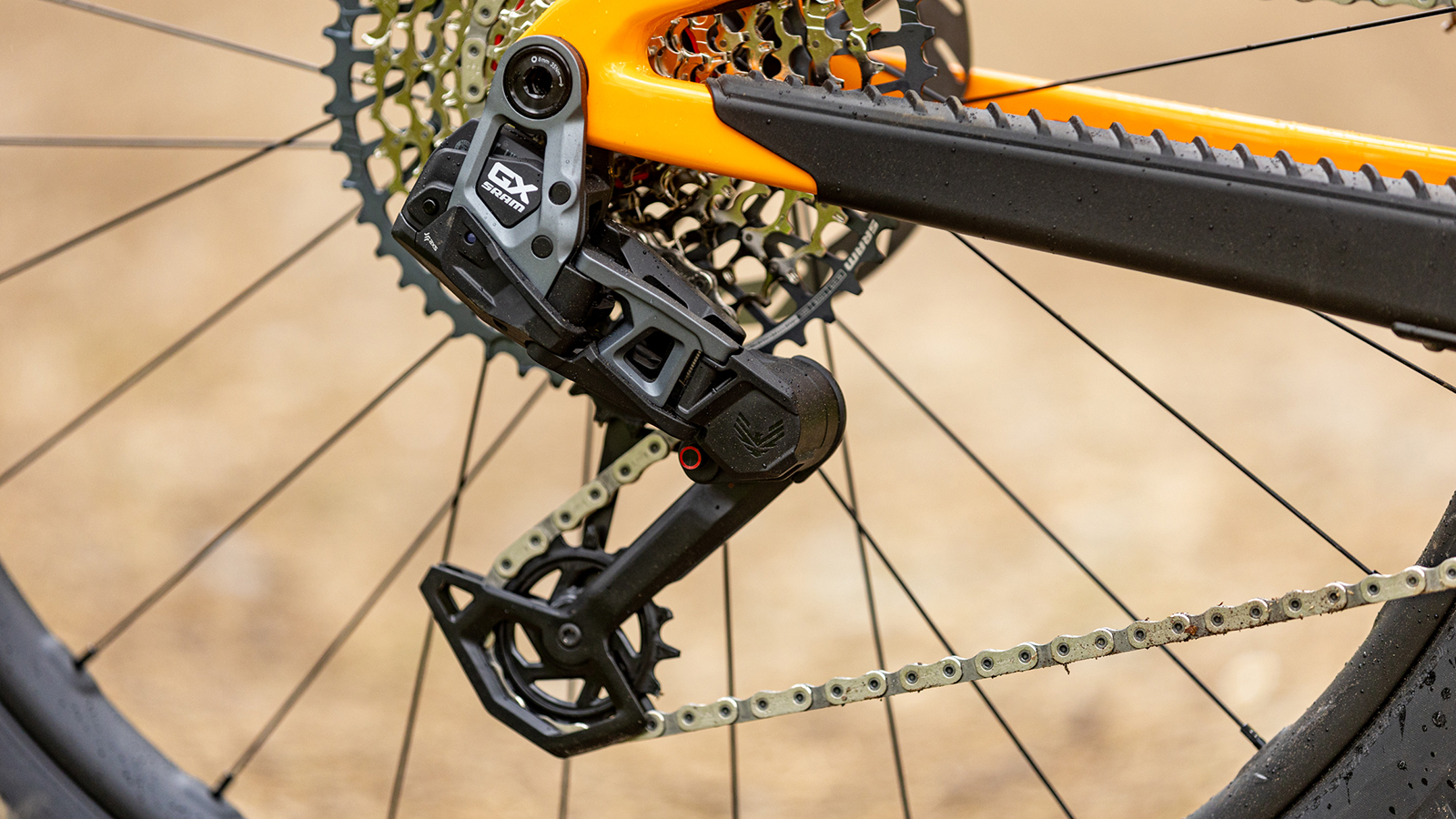
Components and build
With the latest GX Eagle T-Type Transmission, this Tallboy has SRAM’s all-singing and dancing drivetrain with electronic pod shifting and the huge, knock-resistant, rear mech that bolts directly to the frame/hub for extra strength. Rear cogs span from 10-52T for a huge climbing range and the orientation of shifts and how you actually set up the pods is very customizable for a perfect fit for each rider.
Being GX, rather than XO1, Eagle means the rechargeable AXS mech battery is hidden on top rather than exposed out back where I’ve damaged it and lost one on the trail previously. The GX Eagle flat top chain is also coated to offer much better wear life and rust resistance than cheaper models brands often sneak onto complete builds to save costs hoping buyers won’t notice.

Suspension and damping are Fox Performance Elite level at both ends, which is essentially the brand’s best kit without the blingy gold Kashima coating. The fork is a 130mm Float with 34mm stanchions (the Tallboy is rated for up to 140mm front travel) and the rear shock is a slimline in-line Float that doesn’t have the extra reservoir or oil volume some aggro short travel rigs offer.
One massive highlight is the set of Reserve 30 Carbon SL wheels. These things are built up around reliable (but not the fastest-engaging) DT Swiss 370 hubs and retail for big bucks on their own. The Reserve ride quality is fantastic, being urgent, zippy and fast to accelerate sensation, but they are also less sharp and hectic feeding back trail bumps and hits than many traditional rock-solid carbon wheels.
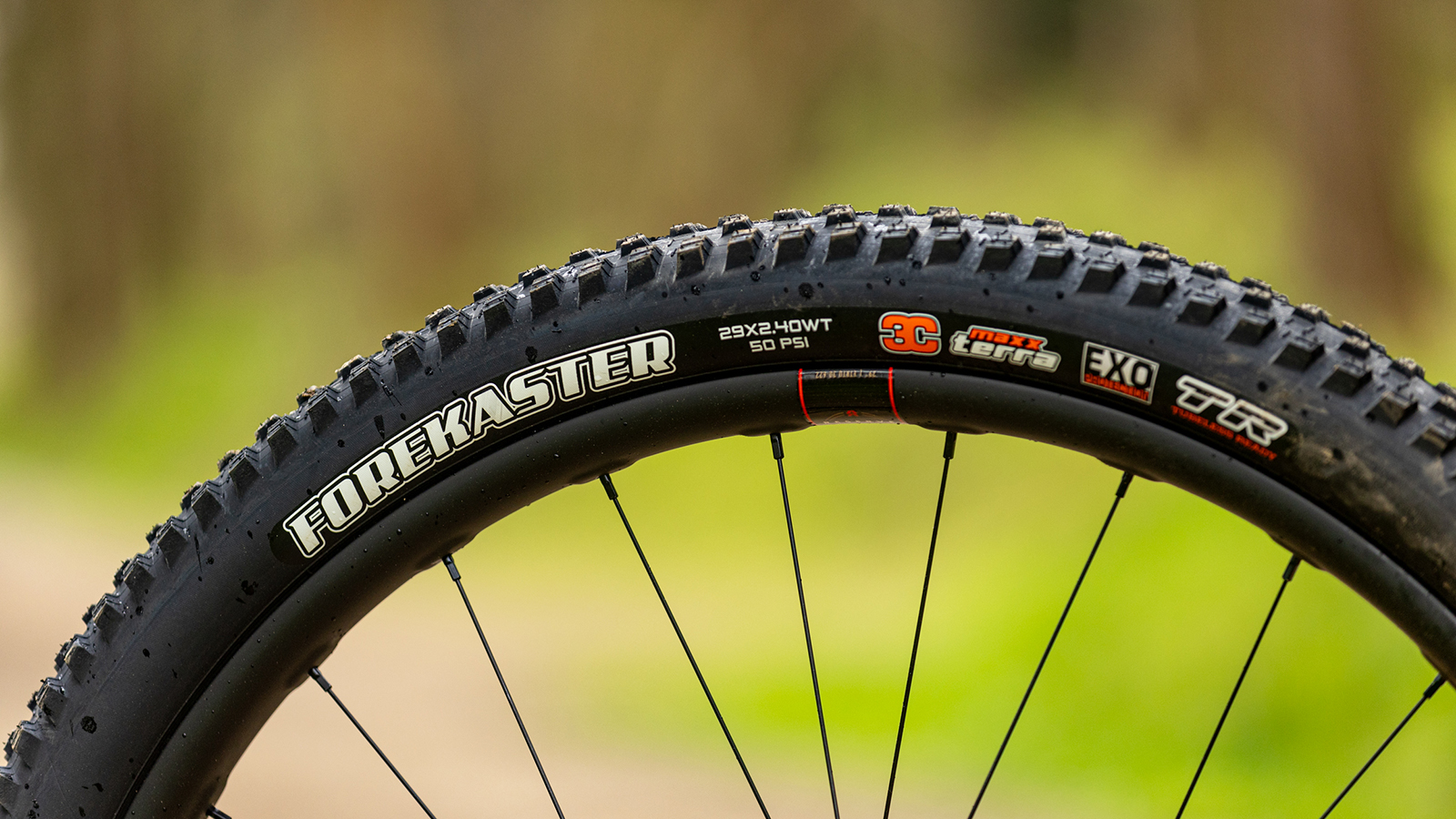
The Tallboy’s trail speed is further boosted by Maxxis Forekaster 2.4in Maxx Terra tires at both ends, which also roll like stink and grip pretty well overall (even in the wet). I have to admit though after pushing my luck a few times too many on the diminutive front tire’s edge blocks, I switched over to a Maxx Terra EXO Assegai to get some more meat to really push into. Certain Tallboy models come stocked with a Maxxis Dissector front and Rekon rear option, which might offer a better balance overall in drier climates.
The SRAM electronic package doesn’t extend to an AXS Reverb dropper; instead, the proven reliable OneUp V2 post shifts the saddle out of the way for the fun bits and works great, but am I the only one who finds the overly sharp remote lever tip can dig in the thumb knuckle under the left grip?
These ‘House Grips’ are Santa Cruz own brand with a great rubber formula, tread pattern and damping, but they do make the solid, 35mm bore, and already wide 800mm Reserve carbon bar even wider by adding around 5mm per side compared to grips with smaller overlapping edge ‘bumpers’. The bars are clamped by another nice detail bit of kit in a flashy forged Burgtec Enduro stem of the kind many riders would actually upgrade to themselves.
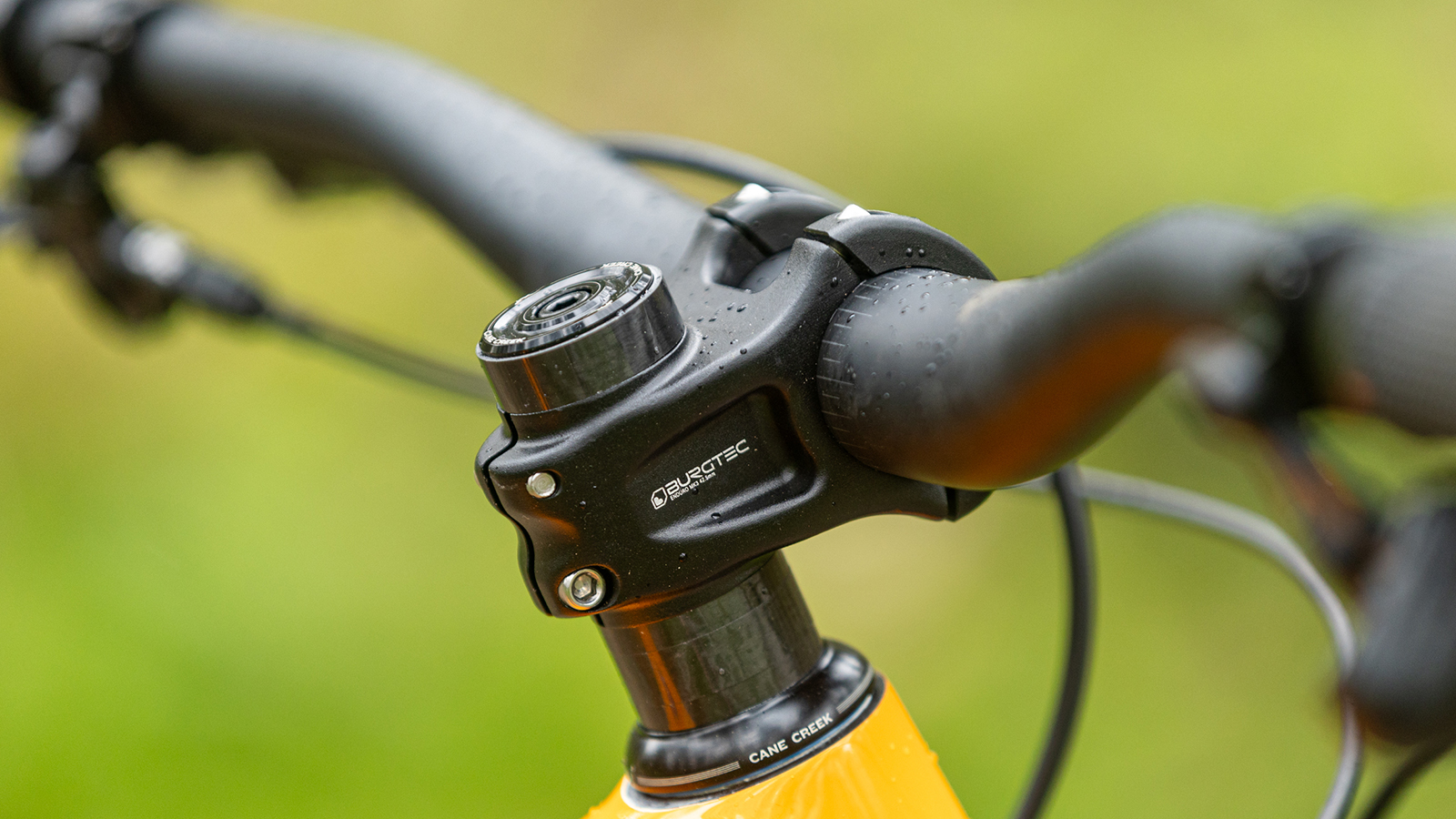
One piece of the Tallboy’s package is pretty dubious though. I’m not sure how many of the downhill-orientated riders that Tallboy targets would opt for SRAM Level brakes. Even with four pistons, they are essentially XC kit and this is by far the worst part of the specification here. The in-line stealth levers look cool, but with 180mm rotors at both ends, the Level brakes (and pads) don’t have much bite or sheer power, and it’s a real struggle scrubbing off speed if you’re really cracking on. I basically found it more a case of ‘slowing down’ than actually ‘stopping’ and swapped out to 200mm rotors at both ends, which fit in fine (the frame can handle 220mm too) and add extra power.
Seeing as bigger HS2 rotors only add about 50g or so extra, and trail or even enduro brakes like Stealth Codes would only add a minimal weight penalty of around 60g per end compared to Levels, you do wonder why Santa Cruz didn’t spec them in the first place, especially on the bigger sizes heavier riders will be buying.
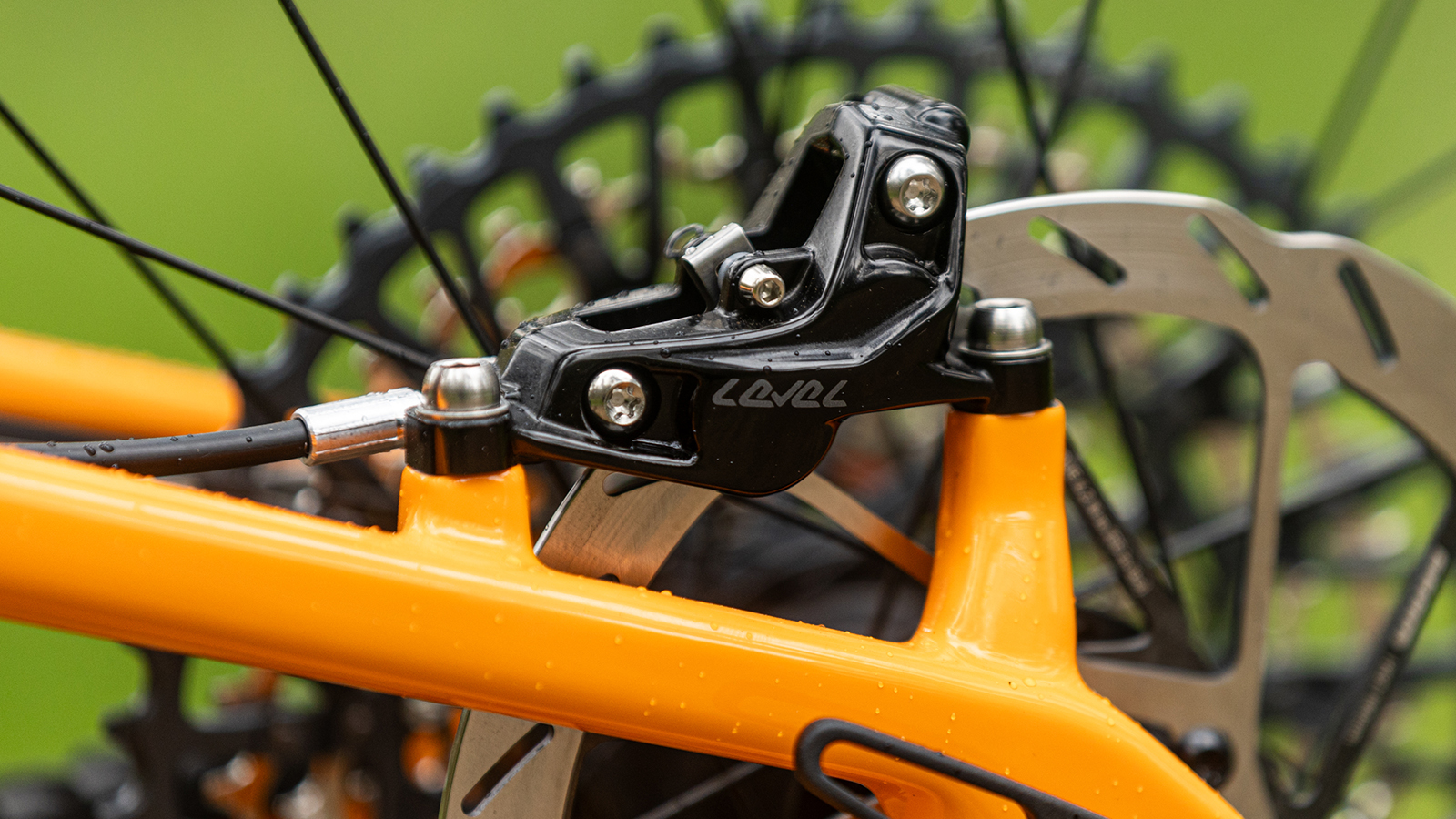
Ride, handling and performance
This need for bigger and more powerful brakes is a direct consequence of the Tallboy turning you into a seriously cocky and confident wannabe shredder, especially considering how much travel you have to play with.
With fast, lightweight 29in carbon wheels, the latest Tallboy is zippy and efficient everywhere, but frankly ridiculously fast when trails tip downhill and there is a need to maintain rolling speed on rough (but not too rough) surfaces. This speed factor is even more noticeable on nice and smooth dirt or feature- and berm-packed trails you pump and milk for extra pace, and it’s here you’ll leave any mates on longer travel rigs for dust as they get sucked and mushed into every hollow and compression while the Tallboy slingshots and generates pace.
Very balanced front to rear, it skims and floats along at a rate of knots, but the back end doesn’t iron out every last bit of trail chatter and small bumps as much as efficiently ignore them. The rear shock feels perfectly tuned, but the suspension is muscular rather than lithe and not especially supple and comfortable. The back end never seems to smash through the travel unnecessarily, but if you absolutely send it off a jump or drop and smash to flat, you know all about having less travel in your feet as the very progressive feel ramps up to resist bottoming and the bike feels like it’s almost bouncing off the rev limiter.
I was mostly running the bike in the lower setting (where there’s more suspension progression) and with slightly less air pressure for a more low-slung cornering feel. But in the higher position, there’s a slightly softer first touch and better mid stroke support and less of that crazy ramp up to bounce off lower in the stroke when punching holes and compressions. I prefer the lower setting, but depending on how you ride, this small flip-chip adjustment offers a meaningful ride feel shift beyond the slight geometry adjustment.

This Tallboy doesn’t scream of being glued to the floor for every ounce of grip or traction like some that are hyperactive around sag and might work better at slower speeds. Instead, the Tallboy simply seems to plough through terrain as if the bumps aren’t there in the manner of a much longer travel machine. This might be a consequence of me setting it up pretty firm though (with around 28 percent sag) to maximize how hard and fast you can ride without running out of travel.
So long as the hits you subject it too aren’t properly DH-sized holes, nothing really slows the Tallboy down (including the brakes) and you frequently find yourself simply rolling away from buddies furiously pedaling and pumping to catch up on the kind of UK ‘enduro’ trails many of us ride that aren’t fall-line steep.
With pretty relaxed angles, it’s way less twitchy than a full-on XC bike, but shares some of the same energy and efficiency under power whether sprinting or climbing, and both ends of the suspension feel in harmony with each other in terms of speed of movement and damping control. The Tallboy accelerates superbly if you stomp hard on the pedals and it never feels like you are wasting excess energy off-road climbing, but I still locked the shock out to climb fireroads and Tarmac for maximum efficiency.
The Tallboy’s steering strikes a great balance between stability and reactiveness and there are moments where it feels absolutely perfect linking turns and features at speed on mellower gradients (like you’d find on Bike Park Wales blue tracks). At my local trails, there is a long gulley with linked bobsleigh-style turns down each side and I can’t remember many bikes that can slice down that thing better. With the steeper head angle than an enduro bike, you can weight the front tire better and the Tallboy cuts and carves down there like stink bouncing from one corner to the next with the rear end flicking side to side behind you that’s always one of the best parts of the ride.
Pretty much everywhere else, there’s a sense you are always following the front tire a bit more on the Tallboy and you can always control and trust in the direct connection you’re feeling on the ground where front tread knobs connect without feeling sketchy or unstable. There’s just about the ideal sense of liveliness and, rather than just being a passenger on a slack angled bike with an inherently greater stabilizing effect on steering. It’s more the overall balance here that’s safely guiding you down the hill than deep travel and slumped angles. It’s a totally engaging and exciting way to ride that adds action and urgency to any terrain – exactly why I keep coming back to riding this kind of sorted short travel bike.
As I mentioned in the intro, I couldn’t tell the difference from memory between this C carbon frame and the CC one and this model still has that very solid and stiff frame feel (especially around the head tube area) but without imparting any of the twanginess or overly sharp feeling that some carbon frames have in this travel bracket.
You often hear that many of us are over-biked, but I’m not about to tell anyone what to ride and understand more travel being safer and how many riders will always want to ride the hardest tracks with the extra control an enduro bike offers. I won’t tell you a bike like this Tallboy can’t get you in trouble either – and for me that’s half the fun. Riders need to be realistic though, because the speed it allows you to go whilst still in control is essentially that of a 160/170mm enduro bike. That’s all well and good until the unexpected happens or it comes time to slow down fast, as there just isn’t the braking traction or cut-in you get with a mullet enduro bike and its grippy rear tire here, so the ‘safety blanket’ effect is greatly diminished.
And because any bike like this rides closer to the edge, it’s also easy to get tempted to the dark side of trying more knobbly and stickier tires and adding more fork travel, but that's a dangerous game that eats into the Tallboy’s peppy character that makes it so much fun in the first place. My view is any closet downhillers like myself just need to chill out a bit and accept the extra sketch of less travel and welcome the bigger bonus of being faster 99 percent of the ride time and how the Tallboy works well for a wide range of riders. My mantra on the hardest DH tracks isn’t ‘maybe I shouldn’t be here on this bike’, more ‘just imagine how much more scared I’d be on most other 120mm travel bikes doing this’.

Verdict
The Tallboy 5 is a bit of a modern classic and one of the fastest and most versatile short travel trail bikes about. Everything from the chassis/ride feel and geometry to the perfectly-tuned suspension works in perfect harmony to boost your fun factor and even with a tiny Fox Float shock, the Tallboy’s back end is simply greedier than any 120mm bike has any right to be, chomping up repeated hits while also pedaling like stink if you give it some beans.
Santa Cruz’s stiff and solid chassis feels precise and rolls along the kind of mellower up and downhills many of us will often ride at a high rate of knots without too much effort and can also handle it if you start absolutely chucking it about. I absolutely love this GX AXS RSV model, but one spec choice any faster/heavier rider will struggle with is the SRAM Level brake package that simply can’t handle the sheer pace the Tallboy encourages.
| Attributes | Notes | Rating |
|---|---|---|
| Downhill performance | Super fast and way more capable than a 120mm bike should be | ★★★★★ |
| Climbing performance | It's a hungry climber too | ★★★★★ |
| Components and build | The only real flaw is the underpowered brakes | ★★★★ |
| Value for money | You always pay extra for the Santa Cruz badge | ★★★ |
Test conditions
- Conditions: Dirt – everywhere from greasy and sodden to baked hard and bobbly
- Terrain: Everything from long distance bridleways and trail centers to full-on DH and enduro tracks
- Temperature: Spring UK weather – 10 to 24 degrees Celsius
Tech specs: Santa Cruz Tallboy GX AXS RSV
- Price: $7,899.00 / £7,799.00 / €7,999.00
- Discipline: Trail/enduro
- Frame: Santa Cruz Tallboy 5 120mm Carbon C
- Fork: Fox Float 34 Performance Elite 130mm
- Shock: Fox Float Performance Elite 190x45mm
- Head tube angle: 65.5° (low setting)
- Seat tube angle: 76.6°
- Chainstay: 437mm
- Wheelbase: 1,258mm
- Reach: 473mm (low)
- Weight: 13.4kg / 29.5lb (size large tested)
- Sizes: XS to XXL
- Drivetrain: SRAM T-Type GX Eagle AXS, 10-52T GX T-Type cassette, SRAM AXS Pod shifter, GX Eagle Flattop chain
- Wheels: Reserve 30 SL carbon w/DT Swiss 370 hubs. 28 spokes
- Tires: Maxxis Forekaster EXO WT Maxx Terra 29in x 2.4in F&R. Tubeless
- Brakes: SRAM Level Silver. HS2 rotors 180mm F&R
- Seatpost: OneUp V2 dropper
- Saddle: WTB Silverado Medium CroMo rails
- Bars: Santa Cruz 35 carbon bar 800mm
- Stem: Burgtec Enduro MK3, 42.5mm
- Rival products: Specialized Stumpjumper, Scor 2030, Transition Smuggler, Evil Following

An ex-elite downhill racer, Mick's been mucking about and occasionally racing mountain bikes for over twenty years. Racing led to photo modelling and testing kit for magazines back in the day, and, nowadays, he's mostly riding enduro-style terrain on conventional and electric bikes. As curious as ever about products and tech, he's as likely to be on the other side of the lens or computer screen rating, reviewing and shooting all the latest gear. Mick's list of regular clients includes Bike Perfect, MBR, MBUK, and most of the leading UK MTB publications at one point or another.
